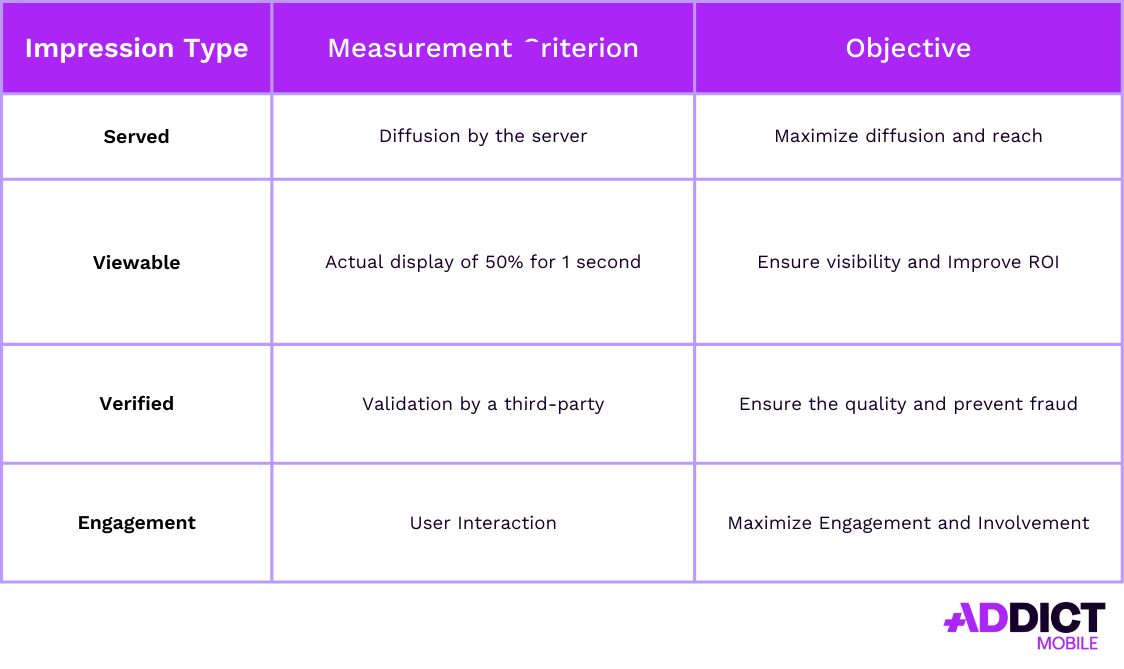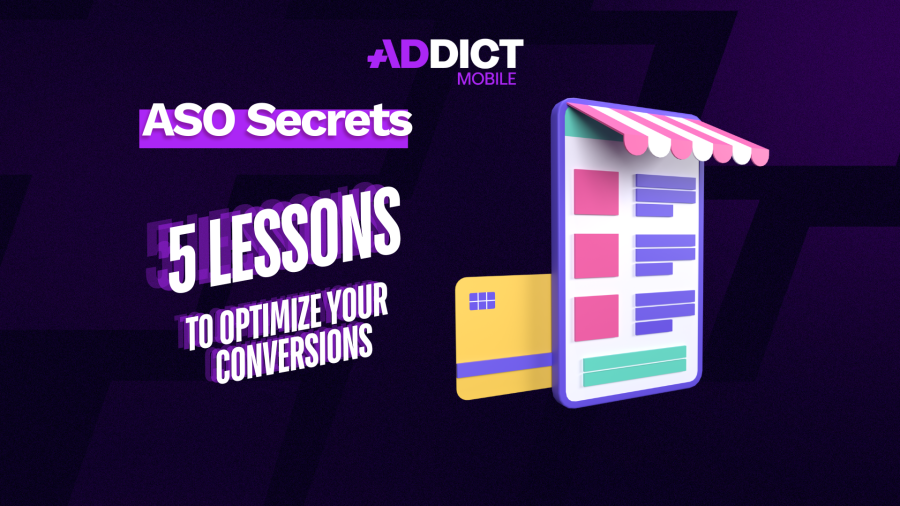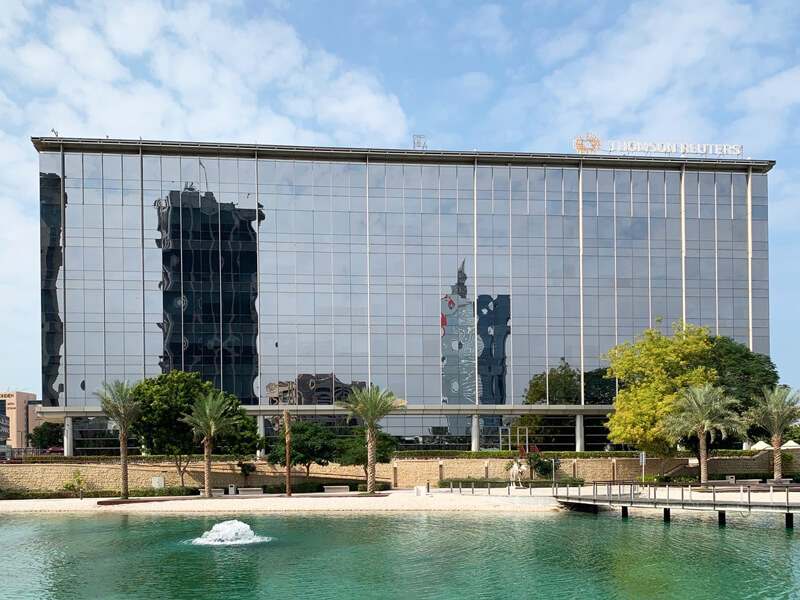Ad Impressions in Mobile Marketing: Understanding and Optimization
Introduction
Ad impressions play a key role in mobile acquisition and digital advertising. Understanding how they work and how to optimize them is essential to maximize campaign performance. This page takes a deep dive into the different types of impressions, how they’re tracked, their impact, and strategies to improve them.
What Is an Ad Impression and How Is It Measured?
An ad impression refers to an ad being displayed on a user’s screen. Unlike clicks or conversions, it doesn’t guarantee direct interaction but marks the first step in the advertising funnel. Impressions are usually measured through ad servers and DSP (Demand Side Platform) systems, and their tracking may vary depending on adopted standards (served vs. viewable impressions).

What Types of Ad Impressions Exist?
There are several types of impressions to monitor depending on your objectives.
Served Impressions
A served impression is logged as soon as an ad is delivered by an ad server, regardless of whether it is actually displayed on the user’s screen.
- When to prioritize: When the goal is to maximize distribution and ensure a high volume of delivery, for example, in awareness or branding campaigns.
Viewable Impressions
Defined by IAB standards (Interactive Advertising Bureau), an impression is considered “viewable” when 50% of the ad appears for at least one second (two seconds for video).
- When to prioritize: To ensure higher visibility and optimize return on investment (ROI), particularly in campaigns focused on engagement or conversion.
Verified Impressions
These impressions are validated by third-party platforms (e.g., MOAT, IAS, DoubleVerify), ensuring they meet visibility standards and are not generated by bots or fraudulent activity.
- When to prioritize: In campaigns requiring quality assurance and transparency, especially for advertisers aiming to avoid ad fraud.
Engagement Impressions
These impressions account not only for ad display but also for user interaction, such as scrolls, hovers, or clicks.
- When to prioritize: When the objective is to encourage interaction and assess user interest in a specific ad format.
Differences between each type

Why Monitor Ad Impressions in Mobile Marketing?
Ad impressions are a valuable metric in mobile marketing because they represent the first point of contact with the user. These data points can be monitored in various contexts:
In Mobile Campaigns
Tracking impressions helps measure reach and ad exposure frequency. A high impression volume ensures broad distribution and increases brand recognition. Conversely, excessive frequency can lead to fatigue and may require adjustments to creatives or targeting.
In Creative Testing and Optimization
Impressions are essential for comparing different ad creative variants. Detailed analysis helps identify which creatives generate the most engagement, which need adjustments, and how to maximize visual and narrative impact. Low impression volume on a creative may indicate issues with appeal or relevance, requiring graphic or textual redesign.
ASO (App Store Optimization)
In optimizing app listings, impressions from Apple Search Ads or Google App Campaigns help evaluate visual and keyword performance in the store. A high number of impressions without conversions may signal a need for creative or keyword optimization. Impression analysis in ASO also assists in budget allocation and identifying the most effective acquisition channels.

Download our guide to boost conversions thanks to App Store Optimization!
Why Focus on Impressions in Mobile UA?
Targeting a high number of impressions addresses multiple objectives in mobile user acquisition:
Boosting Brand Awareness
A large volume of impressions increases visibility for a brand or app, particularly during launch or scaling phases. Maximizing impressions strengthens digital presence and reinforces recall among target users.
Increasing Click-Through Rate (CTR)
The more an ad is seen, the more likely it is to generate clicks. A well-calibrated impression optimization strategy improves CTR and maximizes traffic to the app or landing page.
Fueling Ad Algorithms
Ad platforms (Facebook Ads, Google Ads, DSPs) use impressions to refine their optimization models. A sufficient volume of impressions enhances understanding of user signals and optimizes ad delivery based on conversion opportunities.
Strategies to Increase Ad Impressions
Optimizing the number of impressions is key to maximizing ad reach and visibility. Here are several effective strategies:
Increase Campaign Budget
A higher budget allows more ad delivery to a larger audience. Budget increases directly boost ad frequency, leading to more impressions. However, it’s vital to monitor performance to ensure positive ROI.
- Tips: If budget is limited, optimize campaigns based on geographic regions, platforms, or creatives to focus on top-performing sources.
Broaden Targeting to Expand Audience Reach
Overly narrow targeting can limit ad distribution. To increase impressions, widen your target audience by exploring new demographics, behaviors, or general interests.
- Tips: Use lookalike audiences or data-based audience optimization tools to reach users similar to those who already interacted with your ads.
Adjust Bids and Ad Formats
Bids are a key factor in ad distribution. Adjusting bids ensures your ads appear more frequently, especially in highly competitive environments. Simultaneously, engaging ad formats (like videos or interactive ads) can attract more attention.
- Tips: Test different bid types (CPC, CPM, CPA) and monitor their impact on impressions. Explore adaptive and immersive formats to better capture user interest.
Diversify Acquisition Channels
Avoid relying on a single platform. Diversifying acquisition channels increases impressions and reaches new audience segments. For instance, programmatic campaigns (via DSPs) and social ads (Facebook, Instagram, TikTok) extend reach.
- Tips: Identify the channels with the best ROI and reallocate budgets accordingly. Multichannel activation helps broaden reach and improve frequency.
Improve Creative Quality and Relevance
High-quality, audience-relevant creatives are essential to capturing attention. If ads are perceived as interesting and relevant, they’re more likely to be displayed and shared. Optimizing visuals, messaging, and CTAs according to the audience profile can significantly boost impressions.
- Tips: Run A/B tests on creative variants to identify top performers. Ensure creatives meet each platform’s format and spec requirements.
Use Partnerships and Sponsored Placements
Partnering with brands, influencers, or other apps can significantly increase impressions. Sponsored placements, native ads, or strategic collaborations offer new exposure opportunities.
- Tips: Find partners with similar or complementary audiences and negotiate sponsored placements or co-created content.
Leverage Retargeting
Retargeting involves serving ads to users who previously interacted with your ads or visited your site/app. Re-exposing these users to your creatives increases conversion chances and generates additional impressions.
- Tips: Set up retargeting segments based on user actions (e.g., product page visits, cart additions) to re-engage your target audience.

Do not hesitate to contact with our teams
Addict can support you to improve your performance.
Other Key Metrics to Monitor
- CTR (Click-Through Rate) : Percentage of users who clicked after seeing the ad.
- CPM (Cost per Mille Impressions) : Measures the cost per thousand impressions and is crucial for budget optimization.
- LTV (Lifetime Value) : Assesses the value generated by a user over their entire lifecycle within the app.
- eCPM (Effective CPM) : Evaluates ad inventory profitability by calculating revenue per thousand impressions.
- ARPDEU (Average Revenue Per Daily Active User) : Measures average revenue per daily active user, especially relevant for freemium and in-app purchase models.
Conclusion
Ad impressions are a key indicator for mobile UA campaigns. By understanding the different types of impressions and applying effective optimization strategies, marketers can maximize ad visibility and improve overall campaign performance.


